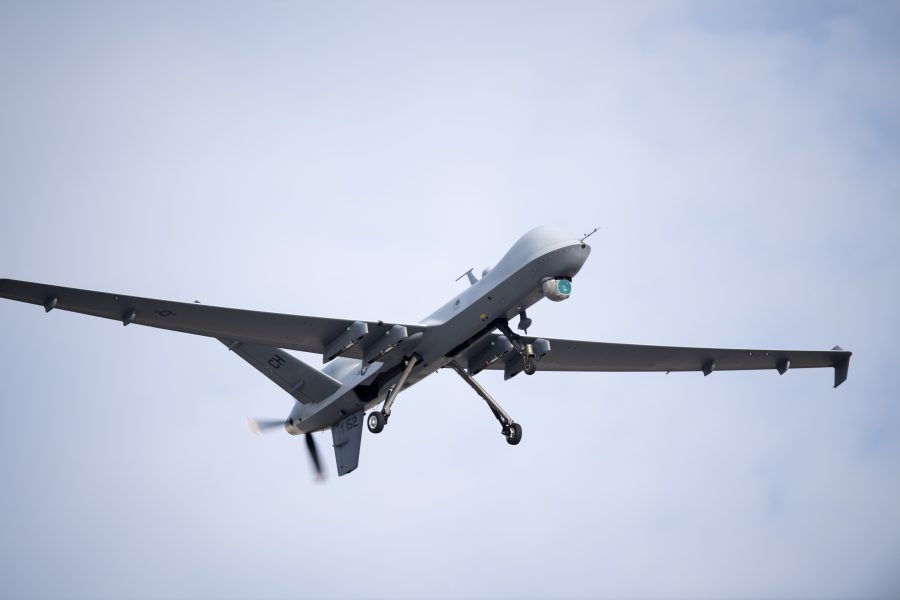An inexperienced pilot’s errors exacerbated by an overbearing supervisor caused a U.S. Air Force MQ-9 to crash into the sea in the Middle East last September, a new accident investigation board report has found.
The Sept. 3, 2023, accident destroyed the $26.1 million aircraft, and had not been disclosed until now. It was among three unrelated Class A mishaps across the service in a five-day span that month.
According to the investigation report, the MQ-9 was launched by a Launch and Recovery Element in Africa, but controlled for its mission by a crew from the 162nd Attack Squadron at Springfield-Beckley Air National Guard Base, Ohio. The mission was within U.S. Central Command’s area of responsibility.
After completing the mission, the MQ-9 was returning to Africa when something in the electrical system malfunctioned. The drone pilot correctly diagnosed the malfunction as a “Starter-Generator failure,” investigators said. But then the pilot failed to follow the malfunction checklist for electrical system issues, making “numerous errors” in the process, and the operations supervisor created confusion over whether the malfunction was something worse that it actually was.
An MQ-9’s electrical systems are usually powered by two independent sources: the starter generator and the permanent magnetic alternator, or PMA. The PMA powers flight-critical avionics, while the starter generator powers things like satellite communications. If the starter generator dies or malfunctions, batteries can power SATCOM and other systems for a little while, and the crew can set a new emergency mission profile to have the aircraft return to base even after SATCOM dies.
In this case, the MQ-9 had enough power from the PMA to fly back to the original launch and recovery element, but the pilot accidentally calculated how much longer the aircraft could fly based on a dual generator failure.
Meanwhile, while the pilot was still working on the checklist, the operations supervisor added to the confusion by telling the pilot to conduct a generator reset—a maneuver that should “only be attempted if the aircraft was assessed unrecoverable,” investigators noted. This created uncertainty about the nature of the malfunction.
Initially, crew members decided to conduct a crash landing at a forward operating base, but the operations supervisor directed the drone pilot to climb and drop the aircraft’s landing gear. That slowed down the aircraft, reducing its ability to reach the base on its remaining power. Pivoting, they decided to crash the MQ-9 into the water near a U.S. vessel.
The pilot guided the drone to a patch of water near the vessel and set it to loiter there shortly before the crew lost connectivity as the battery gave out. At any point before the battery gave out, investigators wrote, the aircraft could have been saved—if the crew had set its emergency mission to return to the launch and recovery element. But when connectivity was lost, without an emergency mission set, the aircraft continued to loiter over the water until it ran out of fuel. That took more than two hours in this case. The bulk of the wreckage was not recovered.
Investigators laid most of the blame on the pilot and operations supervisor:
- The pilot did not properly run the electric systems malfunction checklist, which would have confirmed the starter generator as the cause of concern and ensured the crew set the launch and recovery element as the emergency mission profile.
- The operations supervisor, meanwhile, “was the only voice to the [launch and recovery element] and the Combined Air Operation Centers and in that role was the source of confusion” about the nature of the malfunction, the aircraft’s recoverability, and whether the launch crew could recover the aircraft.
The inexperienced pilot “exhibited poor general knowledge of the electrical system,” investigators added. During a training simulation, the pilot “was slow to recognize and act on emergency management, … made multiple errors and omissions to checklists, … made frequent incoherent statements, and finally … demonstrated scattered skills and below average performance.” He was required to retake the necessary training.
The operations supervisor, meanwhile, “provided excessive advice and direction” and, despite being an evaluator pilot, did not follow the malfunction checklist correctly either. The supervisor was too quick to focus on crash landing, the investigators said, instead of assessing the source of the malfunction and whether a standard recovery was possible.
The Air Force suffered a string of MQ-9 mishaps and downings over the past 18 months.
In January 2023, a contractor crashed a drone, causing $16 million in damages in California. In May 2023, engine failure led another MQ-9 to crash at an undisclosed location in Africa, where it was destroyed. And in September, another contractor was killed after she walked into the propeller of an MQ-9 during ground testing.
On top of that, the Air Force has disclosed at least one MQ-9 crash in 2024—U.S. Air Forces in Europe announced a Reaper crashed in Poland in January.
In addition, six reapers have been damaged or destroyed by Russian fighter jets and Iranian-backed militias since March 2023:
- February 2024: Houthi rebels, supported by Iran, downed an MQ-9 off the coast of Yemen into the Red Sea
- January 2024: An MQ-9 crashed in Iraq. U.S. officials said the Islamic Resistance in Iraq, an umbrella group of Iraqi militias supported by Iran, likely shot down the drone with an Iranian-provided surface-to-air missile.
- November 2023: Houthi rebels shot down an MQ-9 over the Red Sea.
- July 2023: In the span of a few days, Russian fighters intercepted MQ-9s over Syria twice, both times releasing flares that damaged, but did not destroy, the drones.
- March 2023: A Russian fighter collided with an MQ-9 during an intercept over the Black Sea, causing it to crash and be destroyed.
